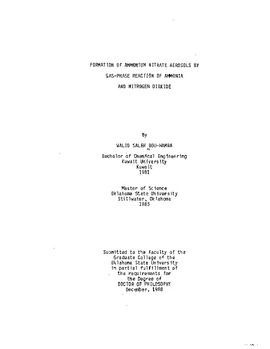| dc.contributor.advisor | Seapan, Mayis | |
| dc.contributor.author | Bou-Hamra, Walid Saleh | |
| dc.date.accessioned | 2015-11-09T22:22:29Z | |
| dc.date.available | 2015-11-09T22:22:29Z | |
| dc.date.issued | 1988-12 | |
| dc.identifier.uri | https://hdl.handle.net/11244/21171 | |
| dc.description.abstract | With the increased emissions of nitrogen oxides, atmospheric nitrate aerosols have become a great concern. The presence of total nitrate in the atmosphere is as much as 25% of the total aerosol pollutants, in which ammonium nitrate is always in equilibrium with ammonia and nitric acid. Although ammonium nitrate is a major pollutant in the atmosphere, very limited data exists on its concentrations and size distributions and mechanisms of formation. The aim of this work was to study the formation and growth of ammonium nitrate aerosols from the gas-phase reaction of nitrogen dioxide and ammonia in air, with the specific objective to identify the mechanisms of aerosol formation and growth. The N0 2-NH3 reaction was studied in a laminar flow aerosol reactor. A TSI differential Mobility Particle Sizer (DMPS), interfaced with an IBM/XT personal computer, was used to measure the size distributions in the range of 0.01-1.0m. The concentrations of the reactants after mixing were in the range of 0.5-14 ppm. The reaction was studied at the atmospheric pressure and in the temperature range of 4.4-21.0 degrees C (40-70 degrees F). | |
| dc.description.abstract | Ammonium nitrate aerosols form by the homogeneous nucleation and grow by the condensation of the monomeric NH4No3 and to a lesser extent by the adsorption of NH3 and HN03 vapors on the particle surface followed by the surface reaction of the adsorbed species. A number distribution equation, based on the condensation equation, fits the measured data well. This indicates that the condensation of ammonium nitrate is the dominant particle growth process. The evolution of the size distributions shows that the growth by volume reaction is not possible and coagulation is not significant in the reaction conditions under study. The experimental critical particle diameter was found to be in the range of 0.018-0.052 m The results showed an average particle diameter in the range of 0.2-0.4 m at the reaction conditions under study. As expected the critical particle size decreased and the concentration increased when the temperature was decreased. | |
| dc.format | application/pdf | |
| dc.language | en_US | |
| dc.rights | Copyright is held by the author who has granted the Oklahoma State University Library the non-exclusive right to share this material in its institutional repository. Contact Digital Library Services at lib-dls@okstate.edu or 405-744-9161 for the permission policy on the use, reproduction or distribution of this material. | |
| dc.title | Formation of ammonium nitrate aerosols by gas-phase reaction of ammonia and nitrogen dioxide | |
| dc.contributor.committeeMember | Rockley, M. | |
| dc.contributor.committeeMember | Robinson, R. L., Jr. | |
| dc.contributor.committeeMember | Foutch, G. | |
| osu.filename | Thesis-1988D-B752f.pdf | |
| osu.accesstype | Open Access | |
| dc.type.genre | Dissertation | |
| dc.type.material | Text | |
| thesis.degree.discipline | Chemical Engineering | |
| thesis.degree.grantor | Oklahoma State University | |
